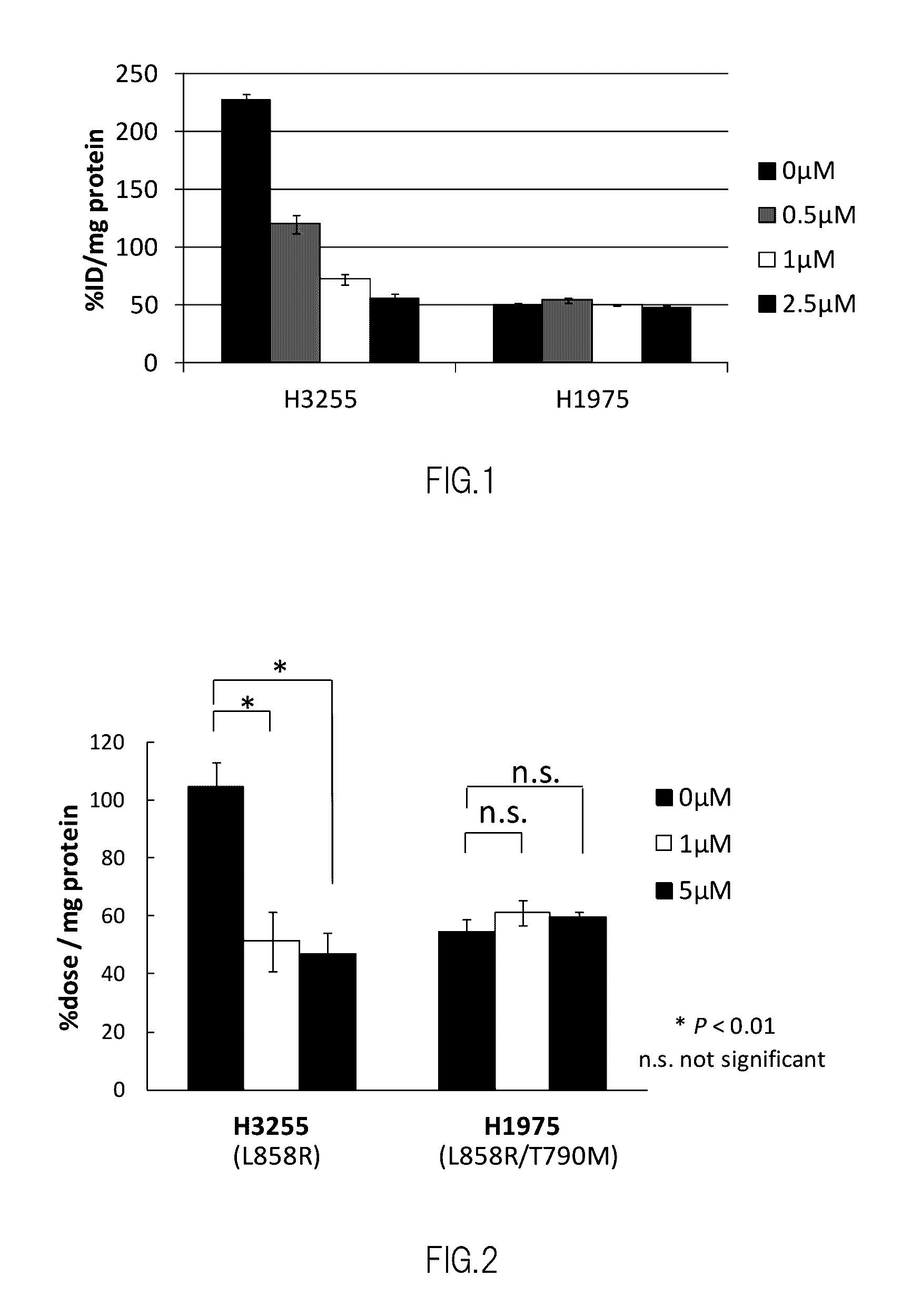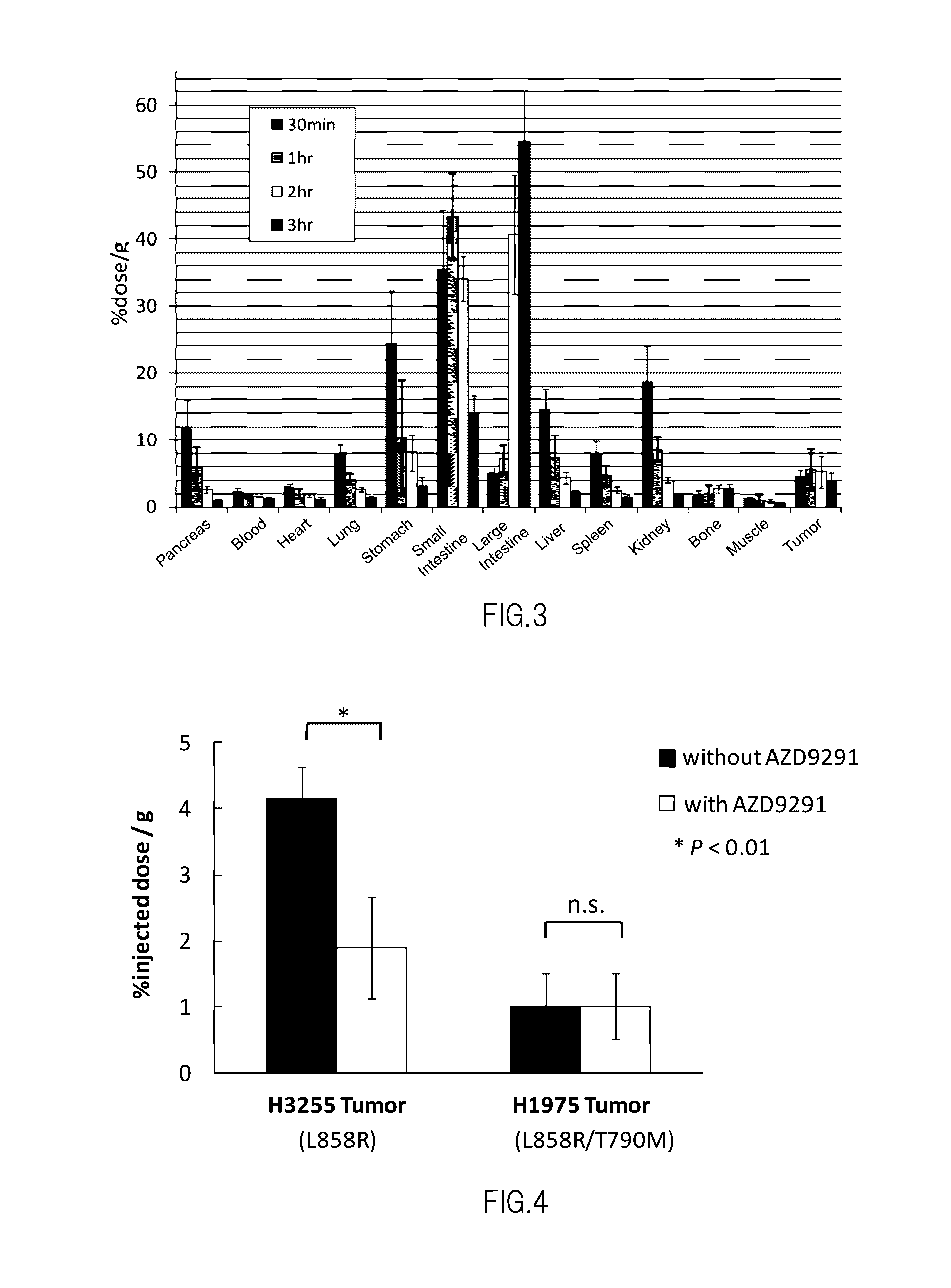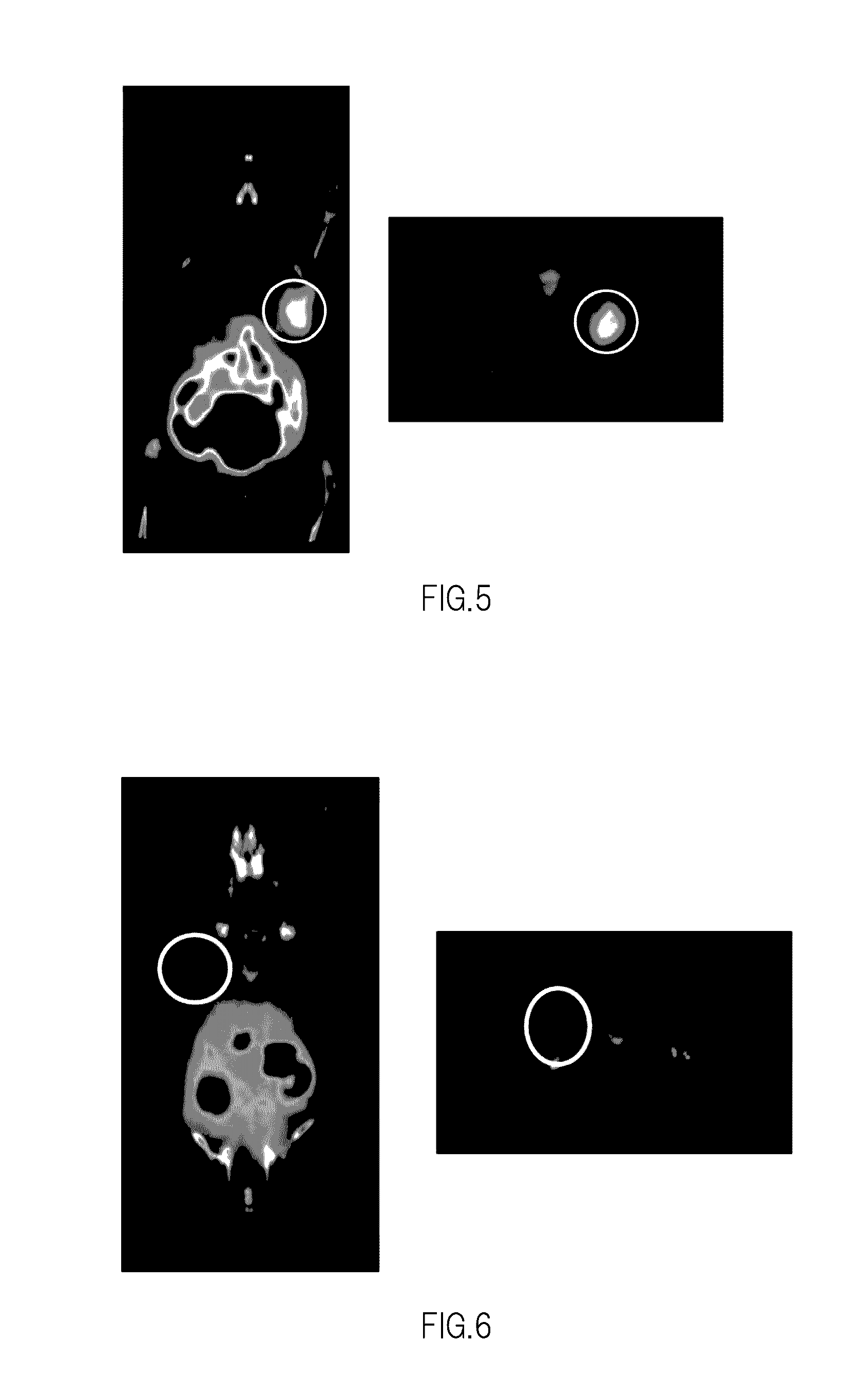Nuclear Medicine Diagnostic Imaging Agent
a nuclear medicine and diagnostic imaging technology, applied in the field of radioactive labeled compounds, can solve the problem that the method capable of noninvasively detecting a secondary mutation of egfr has not yet been developed
- Summary
- Abstract
- Description
- Claims
- Application Information
AI Technical Summary
Benefits of technology
Problems solved by technology
Method used
Image
Examples
production example 1
Synthesis of 4-[(3-Bromophenyl)amino]-6-(2-fluoroethylamino)pyrido[3,4-d]pyrimidine (H1)
[0103]H1 was synthesized according to the following scheme.
(a) tert-butyl 4-(2-aminoethyl)piperazine-1-carboxylate, Et3N in DMSO, 80° C.
[0104]Compound 1 (79.8 mg, 0.250 mmol) was dissolved in DMSO (3 mL), Et3N (697 μL, 5.00 mmol) and 2-fluoroethylamine hydrochloride (498 mg, 5.00 mmol) were added thereto, which then was stirred at 80° C. for 16 hours. After completion of the reaction, the reaction solution was poured into water and then was extracted with ethyl acetate. The organic layer thus obtained was washed with water and brine sequentially and then was dried with sodium sulfate. Thereafter, the solvent was evaporated to dryness. The residue thus obtained was purified by silica gel preparative TLC (CHCl3 / MeOH=10 / 1). Yield 7.9 mg (9%), 1H NMR (400 MHz, DMSO-d6) δ9.69 (1H, s), 8.77 (1H, s), 8.41 (1H, s), 8.19 (1H, t, J=2.2 Hz), 7.90 (1H, br d, J=8.8 Hz), 7.37 (1H, t, J=8.1 Hz), 7.32-7.30 (1H, ...
production example 2
Synthesis of N4-(3-(2-fluoroethoxy)phenyl)-N6-(2-morpholinoethyl)pyrido[3,4-d]pyrimidine-4, 6-diamine (H2)
[0105]H2 was synthesized according to the following scheme.
3-(2-Fluoroethoxy)aniline (Compound 5)
[0106]Compound 4 (1.375 mmol, 1.0 eq) was dissolved in DMF (2.0 mL) and K2CO3 (2.749 mmol, 2.0 eq) and 2-fluoroethyl-4-toluene sulfonate (1.649 mmol, 1.2 eq) were added thereto, which then was heated overnight at 70° C. The reaction solution was extracted with ethyl acetate and then the organic layer was collected, which was dried with sodium sulfate. Thereafter, the solvent was evaporated to dryness. The residue was purified by column chromatography and thus Compound 5 was obtained.
[0107]Yield 140.1 mg (65.7%), 1H NMR (400 MHz, CDCl3) δ7.06 (1H, t, J=8.0 Hz), 6.32 (2H, m), 6.27 (1H, t, J=2.0 Hz), 6.27 (1H, t, J=2.0 Hz), 4.73 (2H, dt, J=47.6, 4.0 Hz), 4.17 (2H, dt, J=28.0, 4.0 Hz), 3.67 (2H, br).
N-(3-(2-Fluoroethoxy)phenyl)-6-fluoropyrido[3, 4-d]pyrimidin-4-amine (Compound 7)
[0108]Co...
production example 3
Synthesis of N4-(6-fluoropyridin-3-yl)-N6-(2-morpholinoethyl)pyrido[3,4-d]pyrimidin-4,6-diamine (H3)
[0111]H3 was synthesized according to the following scheme.
N-(6-Fluoropyridin-3-yl)-6-fluoropyrido[3, 4-d]pyrimidin-4-amine (Compound 8)
[0112]Compound 6 (0.303 mmol) and 5-Amino-2-fluoropyridine (ALDRICH) (0.363 mmol) were heated and refluxed in a 2-propanol (2.0 mL) solvent at 105° C. for two hours. The reaction solution was extracted with ethyl acetate and then the organic layer was collected, which was dried with sodium sulfate. Thereafter, the solvent was evaporated to dryness. The residue was purified by column chromatography and thus Compound 8 was obtained. Yield 20.0 mg (25.5%), 1H NMR (400 MHz, CDCl3) 9.09 (1H, s), 8.81 (1H, s), 8.47 (1H, s), 8.44 (1H, dd, J=8.8, 2.4 Hz), 7.41 (1H, s), 7.06 (1H, dd, J=8.8, 3.2 Hz).
N4-(6-Fluoropyridin-3-yl)-N6-(2-morpholinoethyl)pyrido[3,4-d]pyrimidin-4,6-diamine (H3)
[0113]Compound 8 (20.0 mg, 0.077 mmol) was dissolved in DMSO (900 μL) and 4-(...
PUM
| Property | Measurement | Unit |
|---|---|---|
| pH | aaaaa | aaaaa |
| flow rate | aaaaa | aaaaa |
| diameter | aaaaa | aaaaa |
Abstract
Description
Claims
Application Information
 Login to View More
Login to View More - R&D
- Intellectual Property
- Life Sciences
- Materials
- Tech Scout
- Unparalleled Data Quality
- Higher Quality Content
- 60% Fewer Hallucinations
Browse by: Latest US Patents, China's latest patents, Technical Efficacy Thesaurus, Application Domain, Technology Topic, Popular Technical Reports.
© 2025 PatSnap. All rights reserved.Legal|Privacy policy|Modern Slavery Act Transparency Statement|Sitemap|About US| Contact US: help@patsnap.com



